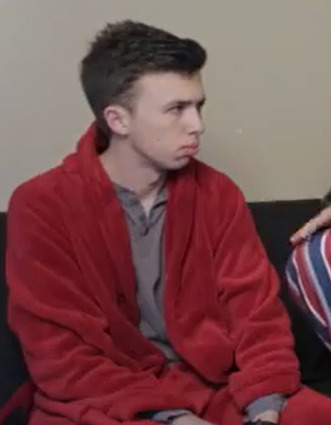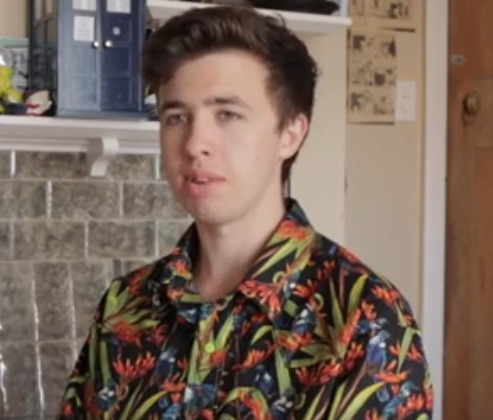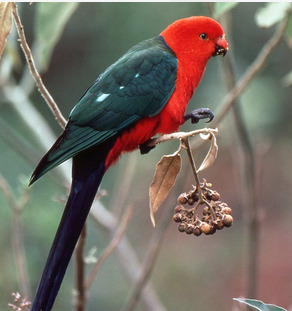The fandom component of this blog is mostly about adaptations of classic English literature. I reblog some gifsets but I tend slightly more in the direction of analysis and meta. Currently watching (or at this point re-watching) Nothing Much To Do (as Nothing Much To Daily; they're reposting each video exactly 10 years after it was originally posted)! Other topics: random personal things, books and authors I like, movies or plays I've seen, modern dance, art, math, other nerdy things, giraffes, the (imagined) middle school lives of small birds, feminism, and the occasional cat. Also, occasionally I post (mostly U.S.) political stuff, generally under the tags #politics and #activism if you need to blacklist to keep your Tumblr dash a happy place.
Last active 60 minutes ago
Don't wanna be here? Send us removal request.
Text
I was reading a fic earlier and cringing a little, so it left me wondering...
#I want the pet names to feel in-character#but also i hate baby as a pet name#too infantilising#tumblr poll#ETA after reading the notes: mommy and daddy as pet names are#so revolting they hadn't even occurred to me as something a writer would use
3K notes
·
View notes
Text


I've been thinking about this dialog a lot lately from Stray.
2K notes
·
View notes
Text
Not to be cliche, but Jane Austen's novels are a lot about how great power & wealth should come with great responsibility, and how most of the wealthy and powerful fail at that. She's asking questions like, "Is that insanely wealthy person polite, charitable, and considerate in a way that befits his station in life?" and she's finding most of them wanting.
2K notes
·
View notes
Text
my spouse and i disagree
#turn the thermostat down means make it colder#but turn the ac down means make the ac less intense#i.e. make it warmer#but i can see how one might interpret it the other way#tumblr poll
6K notes
·
View notes
Text
quiz: why do lobsters have one claw bigger
#puns#this made me giggle#but also#at first#i actually read that explanation as a molar tooth being harder prey#before i realised what it was saying#queue
44K notes
·
View notes
Text
and now, the post you've all been waiting for, benedick hobbes compared to birds


football antics ben and the rose-breasted grosbeak (male)


batman ben and the hooded crow


truth and olives ben and the western yellow robin


returns ben and the australian magpie


rules ben and the gang-gang cockatoo (male)


interview ben and the australian king parrot


break dem rules ben and the crimson rosella
24 notes
·
View notes
Text
I love how, after hitting us with The Letter in Persuasion, Jane's Austen's next line is:
Such a letter was not to be soon recovered from.
Jane is like, that's right bitches, that letter that I wrote is a banger
580 notes
·
View notes
Text
life tip: sometimes there's a bird outside & you can look at it
30K notes
·
View notes
Text

The Dabous Giraffes - neolithic petroglyphs found in Saharan Niger estimated to be 6,000 to 8,000 years old. The bigger of the two giraffes is 5.4 meters long and is the largest known petroglyph in the world.
11K notes
·
View notes
Text
Images from the No Kings protest on Saturday, June 14, 2025:
Minnesota:


Chicago:

San Diego:

Dallas:

Seattle:

San Francisco:

Philadelphia:

Los Angeles:

(source 1, source 2, source 3, source 4, source 5, source 6, source 7, source 8, source 9)
22K notes
·
View notes
Text
14K notes
·
View notes
Text
Big Island Vacation
I didn’t have time to write during our vacation because we sort of didn’t adjust to the time zone, since jet lag worked in our favour for getting up early for various activities—but that also meant we didn’t stay up late enough to have time to post on Tumblr!
But we had a fabulous time. We stayed for a week in the Captain Cook area and then for two nights near Hawaii Volcanoes National Park.
Highlights below the cut.
Snorkeling from Two Step. I was happy that on this visit to Hawaii (the state), unlike the previous two, I managed to rent a flotation vest (not just a flotation belt) with my snorkelling equipment, to give me a little confidence boost. We chose Two Step both because it was near where we were staying and because it involved getting into the water where it was already deep. In the past I’ve struggled with snorkelling from the shore because I often want to come up to adjust my mask, which I can’t do if I’m floating in shallow water over a coral reef. And walking in sand with flippers on is impossible. So this was a perfect way to start, plus Honaunau Bay is sheltered and calm. Even our first snorkelling outing was enjoyable for me; I only felt really panicky for a few seconds at the beginning (anxiety medication also helped). It was so good that we actually went back to the same place the next day as well. In addition to lots of colourful fish, we saw moray eels and a small white-tipped reef shark there.
Visiting Pu’uhonua O Honaunau. This National Historical Park had a really good informational brochure about the cultural importance of the site, which used to be a place where powerful ali’i (chiefs) met as well as a place of refuge where people who had broken the kapu (taboos) / committed crimes could go—if they managed to reach it alive, they could be pardoned instead of being put to death. In addition to what was left of the historical site, there were reconstructions of some structures as well as of traditional canoes.
Shopping at farmers’ markets and fruit stands. We tried several fruits we’d never had before. Our favourite was snake fruit (an Indonesian fruit whose real name is Salak Nanas, I think), which is shaped like a rather large fig and has papery brown skin with a texture reminiscent of snakeskin (hence the name). The fruit on the inside looks like giant garlic cloves, but it’s crunchy and tastes similar to pineapple. We also bought a lot of handmade fruit leather and dried fruit, because you can’t bring fresh fruit home from Hawaii but you can bring dried fruit!
Touring a cacao farm. We got to handle the cacao pods, visit the fermentation and drying shed, and taste the fruit, the fermented but not-yet-roasted beans, and several chocolates made by the company from cacao grown at their orchards in several locations on the Big Island as well as some grown on Oahu. We also got to taste some cold-brew Kona coffee (local!) and see a very tiny pineapple growing on the pineapple plant.
Snorkeling off a boat. This was a great way to snorkel more than one site in the same morning, including places that can’t be reached from land, or at least not easily (like Kealakekua Bay). Riding on the boat itself was a bonus, especially when some dolphins showed up to play with the boat. (They like to race the boat and surf in its wake.)
A guided birding day in Hakalau Forest National Wildlife Refuge. (Wife did not join me for this.) This preserve is only accessible on a guided tour, and the few companies with permits to take visitors are only allowed to take a limited number of visitors per year (including the guide each time!); the company I went with gets 100 slots. We had to disinfect our shoes before entering in order to avoid spreading a fungal disease that causes rapid ohi’a death and which is decimating these native trees. There were 9 of us including our guide, and we had an amazing day. We spotted all of our target species, which were endemic and in several cases endangered. This refuge is one of the few places where some of these birds’ populations are actually increasing. In addition to a number of ‘i’iwi (a red bird with a positively comical beak) and apapane (another awesome red bird), both of which I’d seen in Maui, we saw the ‘akiapola’au, a yellow bird with a ridiculous beak situation (it opens its mouth to use the lower part of the beak, which is straight and sturdy, to peck like a woodpecker, and then uses the fragile, thin, curved upper part of the beak to fish larvae out of the holes), the elepaio (very cute bird), a bright orange akepa (well, most of us saw it), several ‘oma’o (Hawaiian thrush), a number of amakihi, a few alawi, an ‘io (Hawaiian hawk), and, elsewhere, a pueo (Hawaiian subspecies of short-eared owl). We also saw kalij pheasants, which are introduced but play an important role in spreading the seeds of some of the native plants. On our way there we got a look at a Pacific golden plover in its breeding plumage (most of them breed in Alaska, but migrate to Polynesia in winter; however, some of them have apparently decided to bail on migrating and just live year-round in Hawaii -- and who can blame them?!). I got up at 4:30am for this tour, but it was worth it!
Taking a submarine ride. It was only a 45-minute ride but was really a great experience. We saw coral, fish, two shipwrecks, and an eagle spotted ray with its baby! It was fascinating to see these things from underwater rather than from on the surface as a snorkeler. I’m never going to scuba dive, so this was a special opportunity!
Driving around the south coast of the island. This scenic drive included a stop at Punalu’u Black Sand Beach with its sea turtles resting on the sand and others swimming in the surf.
Visiting Kilauea Volcano. We unfortunately missed the big spectacular lava fountains that have been happening intermittently (I’m watching one on the live cams right now as I write this!), but we spent two nights in a comfortable lodge in the rainforest and had a day and a half to explore the volcano. We had a lovely if somewhat klutzy hike doing the Kilauea Iki crater loop, which descends through a rainforest onto the barren crater floor, then across the crater and up the other side. We undertook this hike in heavy mist, and I managed to slip twice: once on an asphalt ramp near the trailhead to descend to the crater, so I had to do the hike with a wet (and slightly bruised) butt, and then once on the crater floor, bruising and scraping my shin on the sharp lava. Still, it was really unique scenery and a bit of a workout climbing back up to the rim. We also visited the Thurston Lava Tube, the Steam Vents, part of Devastation Trail, and Uekahuna. And after dark, we returned to the park to have a distant view (from across the caldera) of the steam from the north vent, which was occasionally glowing yellow. We even saw a few small jets of hot lava spew out, which was exciting—but nothing like what is happening now. A new lava fountain episode started 3 days later and lasted some hours before it went dormant again until today.
All in all, it was a great trip, though we had to skip whole large sections of the island since we only had 9 days.
8 notes
·
View notes
Text
The Original Broadway Cast celebrate 10 years of Hamilton at the 2025 Tony Awards (full performance)
8K notes
·
View notes
Text
do not forget the patron saint of these weeks that we celebrate ourselves proudly and openly in the streets

her name was Marsha P Johnson, and we have her to thank for so much.
remember, the first Pride was a riot, and she was one of the brave souls who endured it to help carve the path which so many of us walk today. she helped found several activist groups regarding LGBT safety and wellbeing. and she was absolutely radiant, too.
thank you, Marsha. we remember you.
207K notes
·
View notes


